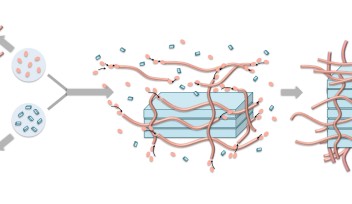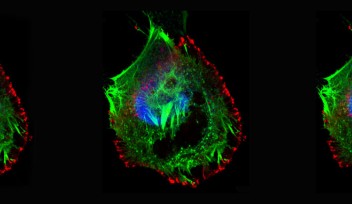Scientists solve chemical mystery at the interface of biology and technology

This article is based on an article written by James Urton at the University of Washington and amended by OIST science writer Merle Naidoo.
At the intersection of biology and technology, researchers are aiming to decipher the cryptic dialects spoken by cells and circuits. With each translation, they bridge the gap between living organisms and medical implant technology.
Digital devices rely on electronic on-off switches to manage current and voltage, while our bodies function through chemistry — in our brains, neurons transmit signals by moving charged atoms or molecules (ions), and not electrons.
Implantable devices, such as pacemakers and glucose monitors, rely on components that can speak both languages and bridge that gap. Among those components are organic electrochemical transistors — or OECTs — which allow current to flow in devices like implantable biosensors.
Scientists have known for a long time about a quirk of OECTs that no one could explain: When an OECT is switched on, there is a lag before current reaches the desired operational level. When switched off, there is no lag and current drops almost immediately.
Prof. Christine Luscombe, head of the pi-Conjugated Polymers Unit at the Okinawa Institute of Science and Technology (OIST), has collaborated with researchers from the University of Washington and Zhejiang University to solve this lagging mystery. In the process, these scientists have paved the way to custom-tailor OECTs for a growing list of applications in biosensing, brain-inspired computation, and beyond.
Their study, published in Nature Materials, found that OECTs turn on via a two-step process, which causes the lag. However, they appear to turn off through a simpler one-step process.
“Understanding the reason behind this switching behavior can allow us to design better materials that allow for faster data processing,” Prof. Luscombe explained.
The unusual switching behavior of OECTs has been recognized by scientists in the past, but the exact cause remained a mystery until recently. Fast switching capability is essential for a wide range of applications.
In principle, OECTs operate like transistors in electronics: When switched on, they allow the flow of electrical current. When switched off, they block it. However, OECTs operate by linking the flow of ions with the flow of electrons, which makes them interesting routes for interfacing with chemistry and biology.
The new study explains the two steps OECTs go through when switched on. First, a wavefront of ions races across the transistor. Then, more charge-bearing particles invade the transistor’s flexible structure, causing it to swell slightly and bringing current up to operational levels. In contrast, the team discovered that deactivation is a one-step process — levels of charged chemicals simply drop uniformly across the transistor, quickly interrupting the flow of current.
Knowing the lag’s cause should help scientists design new generations of OECTs for a wider set of applications.
“There’s always been this drive in technology development to make components faster, more reliable and more efficient,” Prof. David Ginger, project leader and a professor of chemistry at the University of Washington, said. “Yet, the ‘rules’ for how OECTs behave haven’t been well understood. A driving force in this work is to learn them and apply them to future research and development efforts.”
Whether they reside within devices to measure blood glucose or brain activity, OECTs are largely made up of flexible, organic semiconducting polymers — repeating units of complex, carbon-rich compounds — and operate immersed in liquids containing salts and other chemicals.
For this project, the team studied OECTs that change color in response to electrical charge. The polymer materials were synthesized by Prof. Luscombe’s team at OIST and Prof. Chang-Zhi Li’s at Zhejiang University, and then transformed into transistors by University of Washington doctoral students Jiajie Guo and Shinya “Emerson” Chen, who are co-lead authors on the paper.
“A challenge in the materials design for OECTs lies in creating a substance that facilitates effective ion transport and retains electronic conductivity,” said Prof. Luscombe. “The ion transport requires a flexible material, whereas ensuring high electronic conductivity typically necessitates a more rigid structure, posing a dilemma in the development of such materials.”
By observing under a microscope and recording with a smartphone camera precisely what happens when the custom-built OECTs are switched on and off, the scientists clearly showed that a two-step chemical process lies at the heart of the OECT activation lag.
Past research has shown that polymer structure, especially its flexibility, is important to how OECTs function. These devices operate in fluid-filled environments containing chemical salts and other biological compounds, which are bulkier compared to the electronic foundations of our digital devices.
The new study goes further by more directly linking OECT structure and performance. The team found that the degree of activation lag should vary based on what material the OECT is made of, such as whether its polymers are more ordered or more randomly arranged, according to Rajiv Giridharagopal, a scientist at the University of Washington. Future research could explore how to reduce or lengthen the lag times, which for OECTs in the current study were fractions of a second.
“Depending on the type of device you’re trying to build, you could tailor composition, fluid, salts, charge carriers and other parameters to suit your needs,” said Giridharagopal.
OECTs are not just used in biosensing. They are also used to study nerve impulses in muscles, as well as forms of computing to create artificial neural networks and understand how our brains store and retrieve information. Due to their diverse uses, we need to create new generations of OECTs with specific features, including controlled ramp-up and ramp-down times.
The results of this study enhance our understanding of how our bodies communicate with digital implant technologies, which in turn accelerates the development of next-generation applications.
“We’re excited about these findings that will help us develop the next generation of materials for OECTs,” Prof. Luscombe said.
--
This article is based on an article written by James Urton at the University of Washington and amended by OIST science writer Merle Naidoo.
Article Information
Specialties
Research Unit
For press enquiries:
Press Inquiry Form














